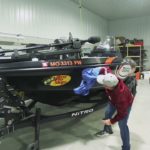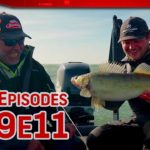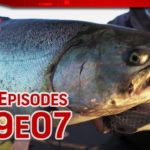Big Water vs Small Water Ice Fishing

It’s often said that walleyes are walleyes wherever they swim. True for the most part, but one of the few times there’s a noticeable difference between populations is when ice fishing-specifically, when you compare walleyes from inland waters with their big-water brethren of the Great Lakes. Although similar locational principles apply wherever you fish, the techniques with which you catch ice walleyes had better be supersized on Lake Erie, Saginaw Bay and the Bays de Noc. Away from the inland seas, subtle is the way to go.
In a way, inland vs. Great Lakes walleyes represent a tale of two fishes. Through the ice on lakes and reservoirs, it’s hard to beat little lures with a piece of bait or a small minnow. On the big water, you can gob up a spoon or a Jigging Rapala with a minnow-a pretty big one, at that-on every hook. Big-time predators, open-water fish accustomed to mowing down shad and alewives, simply like it large. This winter, paying attention to the walleye’s tendencies and giving them what they want are going to mean more fish.
Wherever you fish, it’s important to drill your holes and make your noise as quickly as possible. To get a spread of holes that allows me to fish shallow, deep and in between, I burn holes in the ice with a Strike Master Lazer 224, a four-bladed power auger with a two-horsepower Tecumseh engine. All told, the auger weighs just 26 pounds-just the kind of portability and capabilities necessary to turn the ice into Swiss cheese. When the ice is glare, without a thick carpet of snow to provide traction, the chisel tip comes in handy to drill holes easily, and it lets you efficiently put two holes together when fishing the Great Lakes. That’s where you had better have a big opening in the ice to pull out trophy walleyes.
On that glare ice-or anywhere slippery-Strike Master’s Get a Grip treads provide traction without tearing up shanties or even the inside of a truck. The Get a Grip Advanced Ice Treads slide over boots or shoes and are made with carbide spikes that won’t slice whatever you’re walking on. They just give a great foothold for ice fishing.
To keep tackle organized, pick up a Plano 4600 Guide Series box, a clear-plastic piece of storage that, at 11 inches long, will fit in the pocket of a parka. For something smaller and waterproof, there’s the Plano 3540 with an O-ring around the edge to keep out moisture. Another favorite is the Northland Tube-It, a tackle tote that hangs around your neck and has small plastic tubes to hold terminal tackle and important jigs and lures.
Between the traction and the auger-to say nothing of great tackle to try-it’s up to you to drill as many holes as possible over productive water. For starters, I look for large, flat areas near some current-prime feeding territory. It’s important that the flat is near deep water so the walleyes don’t have to roam far to feed. When punching holes, I put them out in the depths over soft bottom, on the edge of the drop and atop the flat. Even better is hard bottom such as gravel atop the feeding flat.
Whether I’m on inland waters or the Great Lakes, I rely on electronics to find key areas. On inland waters, I might take my GPS coordinates from open-water fishing to pinpoint a rock pile or a gravel patch on a point. If I’m on bigger water, I’ll go into the garage and power up my Lowrance Global Map unit, with its electronic multimedia chips that contain contour lines on the water I’m fishing, and scroll around until I find places I’ve caught fish near key breaklines. I’ll also pay attention to hard bottom or sharp turns, write down the GPS coordinates and then go out with a hand-held unit to find the spot on the spot below the ice. With Fishing Hot Spots Hot Maps, which install in Lowrance units, or on the company’s CD-Rom units for personal computers, I’ll check for wrecks too – a key fish-holding area in winter. On big water like the Great Lakes, a wreck near a two-foot drop is often enough to concentrate winter walleyes. Combine the edge of hard and soft bottom with a little bit of current, and you’re in business.
 Wherever you fish, it’s important not to overdo the jigging motion, a lesson I learned from watching walleyes on my Aqua-Vu underwater camera. While short strokes of a few inches will draw walleyes in, very seldom does the same jigging motion trigger them. When you spot walleyes that come in to investigate, either on an Aqua-Vu or on a liquid-crystal fish finder, immediately slow down your jigging. That’s when I seldom give the lure more than a shake or a jiggle. Most of the time, I can get the walleye to bite by slowing down. If the walleye doesn’t commit, I slowly reel the lure up and keep jiggling and reeling – I’ve had walleyes nail a lure six feet below the ice over 30 feet of water.
Wherever you fish, it’s important not to overdo the jigging motion, a lesson I learned from watching walleyes on my Aqua-Vu underwater camera. While short strokes of a few inches will draw walleyes in, very seldom does the same jigging motion trigger them. When you spot walleyes that come in to investigate, either on an Aqua-Vu or on a liquid-crystal fish finder, immediately slow down your jigging. That’s when I seldom give the lure more than a shake or a jiggle. Most of the time, I can get the walleye to bite by slowing down. If the walleye doesn’t commit, I slowly reel the lure up and keep jiggling and reeling – I’ve had walleyes nail a lure six feet below the ice over 30 feet of water.
This is where my Lowrance X-87 figures in. Since an interested walleye will chase a lure out of camera range, you need a fish finder to see if a fish keeps following. If it does, keep raising the lure and jiggling it. If the fish won’t commit and plummets back to bottom, drop your lure back down and start the process over again. When the walleye again shows interest, keep bringing it off the bottom. Sometimes you have to play cat and mouse with a walleye for as long as 15 minutes. This approach works both inland and on the Great Lakes, though it excels with open-water predators in places like Erie and Bay de Noc.
For a complement to my jigging lures, I’ll put down a plain leadhead jig, normally an eighth- or quarter-ouncer, with a minnow. Many times, particularly on Saginaw Bay, a plain, unpainted jighead with a minnow hooked through the lips is just what the walleyes want.
So just what the walleyes want? On inland waters, it’s usually something small and mellow. On the Great Lakes, it’s normally something big and garish. And when you match the lures and accompanying baits to the walleye’s prevailing behavior, you’re going to have the right stuff, whether it’s subtle or supersized.
Another option is green weeds. The brown ones that are dying give off carbon dioxide-not the right choice. But when weeds are green, they give off oxygen and hold bugs and baitfish, which in turn attract walleyes. Just be sure not to drop an offering too far down into the weeds; elevate it just enough to stay above the weeds, where the walleyes move in to feed.
 Now comes the time to trigger the fish. On inland waters, I always downsize my offerings. Instead of a No. 5 Jigging Rapala, I opt for a smaller No. 3. The reason is that you’re dealing with smaller baitfish and less-aggressive walleyes than the Great Lakes predators that chase down big mouthfuls over vast stretches throughout the year. Likewise, I’ll downsize with lighter line-say, six-pound test-and incorporate a subtle second rod. While I jig a Rap or a spoon, I’ll have a dead rod with a Northland Fire-Ball Jig or a simple plain hook with a split shot with a minnow. (Check out the new colored split shots, called Hot Spots, from Northland.) That second rod will often catch the fish that come in for a look at the jigging lure but opt for a minnow that’s just sitting there.
Now comes the time to trigger the fish. On inland waters, I always downsize my offerings. Instead of a No. 5 Jigging Rapala, I opt for a smaller No. 3. The reason is that you’re dealing with smaller baitfish and less-aggressive walleyes than the Great Lakes predators that chase down big mouthfuls over vast stretches throughout the year. Likewise, I’ll downsize with lighter line-say, six-pound test-and incorporate a subtle second rod. While I jig a Rap or a spoon, I’ll have a dead rod with a Northland Fire-Ball Jig or a simple plain hook with a split shot with a minnow. (Check out the new colored split shots, called Hot Spots, from Northland.) That second rod will often catch the fish that come in for a look at the jigging lure but opt for a minnow that’s just sitting there.
Other lure choices when I’m inland are Northland’s Fire-Eye, a cross between a jig and a spoon, and the Forage Minnow, another crossover that sits horizontally in the water. The Forage Minnows come in holographic colors, which is important in clear water. In clear water, I like colors such as holographics or black and silver or blues. If the water has more stain, I’ll switch to firetiger and bright orange. It never hurts, either, to add a little bit of scent-perhaps some Dr. Juice-for inland or Great Lakes walleyes.
When chasing Great Lakes monsters, I’ll beef up accordingly. I’ll use 10-pound Berkley Vanish Fluorcarbon instead of six pound or switch to 10-pound Berkley FireLine, which has little stretch to set hooks into big fish and the abrasion resistance to wrestle them through the hole, which would shred most monofilament. For lures, I immediately go with a No. 7, No. 9 or No. 11 Jigging Rapala. For better hookups, I switch the treble to one size larger, and at times I’ll add a FireLine stinger to nab short strikers. For Great Lakes fish, I put a big minnow on that treble, or sometimes I’ll put a minnow on each of the treble’s hooks as well as the ones at the head and tail of the Rap. Another way to bulk up the profile of a jigging lure is to cut the minnow in half and thread the head on the front hook and the tail on the back hook. Try it. When using spoons such as Northland’s Buck-Shot Rattle Spoon, a noisy offering that draws walleyes from a distance, I’ll put a minnow on each hook.





